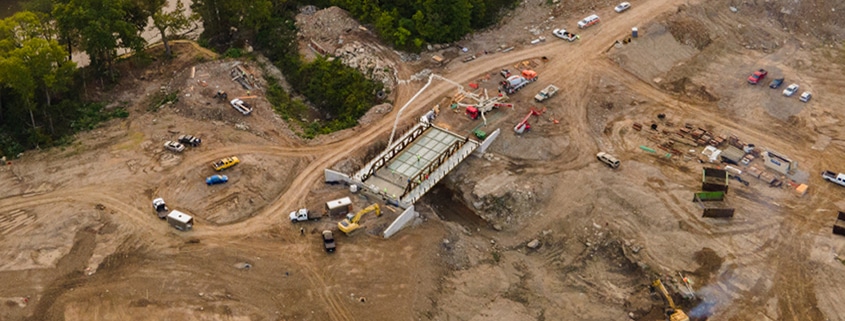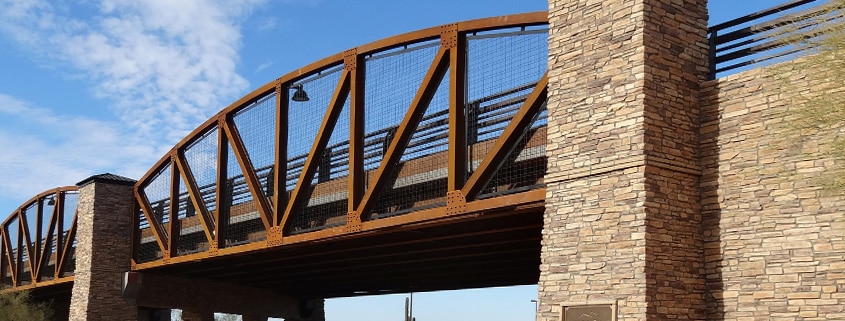Accelerated bridge construction is growing, but there are still many misconceptions surrounding this construction process. Often these ideas stem out of traditional approaches to bridge construction and don’t take into account changes in technology or updated design and construction practices. We want to help builders dismiss these accelerated bridge construction myths and take advantage of the options for efficient construction available to them.
Here are four of the most common accelerated bridge construction myths that are easy to dispel.
Four Popular Accelerated Bridge Construction Myths:
- Accelerated bridge constructions are only for temporary use.
- Accelerated bridge constructions are one-size-fits-all.
- Timber decks are not a good material for accelerated bridge constructions.
- Steel is not competitive for bridges less than 140ft in length.
Myth: Accelerated Bridge Constructions are only for temporary use
Truth: While prefabricated bridges were originally intended for temporary use, they are quickly rising in popularity for permanent construction. Prefabricated bridges are most notably known for their efficient assembly, and they are evolving to fulfill permanent bridge requirements.
The steel bridge members are built in a controlled environment such as U.S. Bridge’s facilities. This not only allows a smoother construction experience process but also ensures ideal conditions for quality permanent bridge construction.
Myth: Accelerated Bridge Constructions are one-size-fits-all
Truth: Prefabricated bridges are custom-built and designed specifically for each project. Thus, they are just as flexible as on-site construction bridges. Our team uses their expertise to design our prefabricated bridges for every setting, from vehicular to pedestrian to utility and private bridges.
As such, there are various options for building prefabricated bridges; builders can use materials such as steel, concrete, asphalt, and even timber. They can also choose the exterior appearance of the bridge. The options are only limited by the project itself such as location and purpose.
Myth: Timber decks are not a good material for prefabricated bridges
Truth: There is a misconception that timber decks do not hold up well for prefabricated bridges. However, the improvements in timber bridge deck design allow this material to be competitive and effective.
These decks are built with glued-laminated wood and directly fastened onto steel stringers. Thus, the use of glulam structural members significantly increases timber bridges span length and carry capacity.
Myth: Steel is not a competitive material for bridges less than 140-feet in length
Truth: Perhaps the most competitive aspect of the use of steel in short span bridges is that it can save builders money and time. Due to its lightweight composition, less heavyweight equipment is required for installation. In addition, with a member of U.S. Bridge’s team to assist in on-site construction, the process can move efficiently.
In general, prefabricated steel bridges compare well against other options when considering factors such as field labor and installation speed and cost. Faster construction time means avoiding delay related losses.
Additionally, when prefabricated bridge constructors receive discounts for purchasing in bulk. Thus, materials are less expensive and can assist with alleviating environmental mitigation costs.
Choose U.S. Bridge for Accelerated Bridge Construction
Ultimately, these myths are ancient history. Prefabricated bridges are very adaptable to fit almost all bridge projects. Accelerated bridge constructions are modular and built in a controlled location such as a factory and installed on-site. Not only do we manufacture the materials needed for your project, but we also send a member of our team to ensure the efficiency of construction.
U.S. Bridge has been engineering and manufacturing bridges for decades. Our experience makes us confident that we can meet the needs of your project and deliver a long-lasting bridge
We recognize and understand that your bridge is a major investment. So, we’re here to help you from the beginning of your project through the end. Contact us for a free quote, or use our exclusive bridge design tool Bridge Scope.


